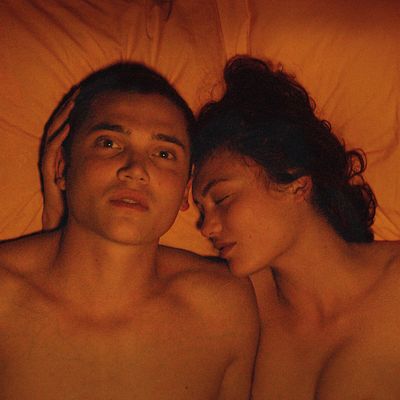
It’s hard to talk about Gaspar Noé’s Love without talking about its opening scene, so let’s get it out of the way: It’s a lengthy, fixed 3-D shot — running for something like three minutes — of a naked couple in bed, manually pleasuring each other. (“A sweet double hand job” was how Noé himself described it to my colleague Jada Yuan in this great profile here.) Nothing is left to the imagination, as she finishes him off. Shocking? Scandalous? I’m not so sure. We’re far removed from the days when Last Tango in Paris almost landed Bernardo Bertolucci in prison and Henry and June broke ground on the NC-17 rating. I daresay it’s not the explicitness that makes Love feel new, or controversial; it’s that it makes sex look awesome, which is something most movies stopped doing a long time ago.
Noé can be a subtle director when he wants to be, but he also knows the value — both the shock value and the thematic value — of bluntness, of can’t-turn-away-clarity. His 2002 masterpiece Irreversible, which told its story backwards, opened with a guy getting his head bashed to a pulp in close-up, then worked its way back to the extended, horrifying rape scene that caused the brutal act; keeping such moments of original sin to the realm of mere suggestion would have undermined that film’s entire narrative strategy.
Irreversible came with warnings that it might make you vomit in the theater. Love comes with buzz that it might get you off, and the sex here is certainly unsimulated, extensive, and beautiful. But it’s not “raw,” whatever that means. Noé’s compositions — even in Irreversible, with its drifting, handheld long takes — always have an etched-in-stone quality. His characters stand out in foregrounds, as if they’ve been carved out of light; they move slowly, rarely ceding their corner of the frame. (And now, shot in 3-D, they stand out even more.) His worlds may be replete with dance music and drugs and occasional pop culture signposts, but they’re also timeless.
That closed-off, subjective quality works well for Love, which takes place almost entirely in one man’s mind. That opening sex scene, it turns out, is a memory — one of many being nursed by aspiring filmmaker Murphy (Karl Glusman) of his artist ex-girlfriend Electra (Aomi Muyock) as he mourns their long-dead, once-sexually-adventurous relationship. He now lives with another woman, Omi (Klara Kristin), with whom he has an infant son. And, as so often happens, he feels trapped. “I wish I didn’t exist right now,” he murmurs in voice-over as he lumbers through the narrow corridors of their flat. “This place is a cage.” It’s been two years since Murphy and Electra broke up, and her mom has called him in despair, saying she hadn’t heard from her daughter in months and that the girl sounded suicidal the last time they spoke.
Murphy makes some stabs at trying to track down Electra, who is an addict, but he seems to be searching for her more in the folds of his memory than in the real world: As we go back over their relationship, we also see how it sowed the seeds of its own ruin. And throughout, we get sex — lots and lots of it. Hate sex, love sex, threesome sex, experimental sex. Movies that depict such explicit sex usually make a point of de-glamorizing it, or at least normalizing it — showing ordinary people with fairly ordinary (or “ordinary”) bodies having sex in ordinary ways, in part as a way to reclaim it from the world of pornography. Noé, however, seems to be after something different, almost quaint — as if he wants to reclaim the pornographic itself for the world of art: The figures in Love, while not necessarily of the ripped-dude-with-ten-inch-schlong and enhanced-chick-with-ten-inch-heels variety, are still well-built and smooth in all the right ways, and they’re often clearly performing for our benefit: They’re posed for the cameras, not for each other. But that’s part of the idea, too. The sex scenes in Love, which take place in a half-remembered past, traffic in fantasy. For Murphy, who lives entirely in his mind, Elektra has already become an object of pure, unattainable desire; we’re watching his fap reel of regret.
This closed-off quality won’t be easy for everyone to stomach, and Noé’s discomfort with English-language dialogue won’t help matters much. It’d be easy to dismiss Love as arty and empty, to just snidely say, “The sex is real but the people are not!” But that, I think, misses the point. Noé doesn’t populate his films with people, he populates them with variations on himself. This has never been truer than it is in Love: From Murphy, the Kubrick obsessive who says he wants to “make movies out of blood, sperm, and life,” to Murphy’s young son, named Gaspar, to Elektra’s skeezy gallery-owner ex, played by Noé himself, to another character named Noé. This is not a rich, novelistic tapestry of humanity; this is a solipsistic world, enclosed on all sides by the director’s ego. But the entrapment is vivid and poignant. Look past all the beautiful people fucking, and you realize that Love is sad in all the right ways.


